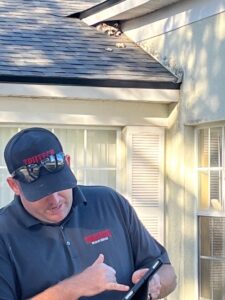Raccoon Control in Orlando, FL
Do you need to get rid of raccoons? We can help!
Some Geographic Restrictions

Raccoons in Orlando
The raccoon population in Orlando, Florida, is healthy and thriving, largely due to the adaptability of the species to urban environments and the availability of food and shelter provided by human activity. If you see a raccoon on your property or see signs of raccoon activity, it’s time to start thinking about how to remove it. Raccoons can damage your home and carry diseases that can be transmitted to humans.
Trutech Wildlife Service specializes in raccoon removal in Orlando. In order to remove and control a raccoon or family of raccoons on your property, our wildlife specialist will perform a thorough inspection to ascertain the severity of the raccoon infestation. After the inspection, they will build a custom solution to trap, remove, and seal all entry points. They will also provide warranty options as well as an estimate for preventative services.
Raccoon Control in Orlando

Raccoon Trapping
Based on the inspection, we develop a custom plan to solve your raccoon problem. The first step is to get the raccoon out of your house. The most effective method is to use a cage or box trap. We set the trap with the best bait to only catch raccoons. Relocating trapped raccoons depends on local laws and ordinances. Direct capture is rarely used.

Raccoon Exclusion
Raccoon exclusion services are the most effective raccoon control. Exclusion devices work immediately and offer long-term control. After raccoon removal, it is imperative to seal all entry points to prevent future raccoon problems. Raccoons can squeeze into a four to five inch gaps. When they cannot find a hole big enough, they create it. At Trutech, we install the proper materials on all potential entry points to keep raccoons out.

Attic Restoration
Once your home is secure, we repair and restore it. Raccoons do considerable damage in the attic. We apply sanitization agents to neutralize raccoon feces and urine. In extreme cases, we replace the insulation. Ectoparasite treatments will exterminate any pests like ticks and lice left behind from the raccoon. Proper sanitation prevents diseases.
Raccoon Problems

Evidence of Raccoons in Orlando
You can recognize raccoon activity by their unique tracks, noises, and droppings. The experts at Trutech look for these specific signs to determine if you have raccoons in your attic.
Recognize Raccoon Tracks
Raccoon tracks resemble tiny human handprints with five fingers extending from the palm. Hind paw tracks are similar but show elongated heels that sink deep into the ground. Raccoons have unusual gaits, carrying most of their weight on their back ends. That puts the fore and hind paw tracks side by side or slightly offset.
Recognize Raccoon Noises
You will primarily hear raccoon noises at night when the pests are most active in their search for food. Even when raccoons are quiet vocally, they still make noise. The sound of an animal rustling or scurrying about the attic or chimney is a common sign that a raccoon has moved in.
Typical raccoon sounds also occur when the pests walk across rooftops, construct their dens, or attempt to gain entry through holes or other small openings that lead to attractive denning sites. You can also hear raccoons communicating using various sounds.
Raccoon sounds range from the vocalizations the animals use to communicate with each other to the noises they make due to their rustling, scurrying, and other activities. Known to be highly vocal creatures, raccoons interact using more than 200 sounds, including purring, chittering, growling, snarling, hissing, whimpering, and even screeching like owls. Baby raccoon sounds include mewing, crying, and whining.
Recognize Raccoon Poop
Raccoon poop is often found in select areas of an attic. The droppings are tubular, have blunted ends, and are usually dark in color, though coloration is subject to change depending on what the animal has recently consumed.

Raccoon Damages
Raccoon damage to yards, roofs, and houses costs homeowners thousands of dollars in yearly repairs. These pests are smart and constantly searching for food and shelter. Their agile paws allow them to tear into materials that would deter other animals, resulting in harm to property.
Not only can a raccoon damage your lawn by digging holes for insects, but it will also raid gardens, bird feeders, and pet food containers. If you have a swimming pool, expect a raccoon to take a dip during the night.
The most expensive problems occur when raccoons take shelter in houses. The pests are strong enough to pull shingles and boards from roofs to climb into attics. They destroy soffits, fascia boards, shingles, vents, and insulation to establish denning sites. Once a raccoon creates or enlarges a hole in the rooftop, it becomes an easy pathway to the attic.
Chicken coops often face danger when raccoons are present. Hungering raccoons capable of opening fence latches can find their way inside and destroy birds, nests, and eggs.
Raccoons in Attics in Orlando
How Trutech Gets Rid of Raccoons
Raccoon in Attic Removal
Raccoons are excellent climbers. They use tree limbs, downspouts, or even siding to gain access to your roof. Once on your roof, entry points include shingles, loose soffits, eaves, vents, or roof returns. Once inside, damage caused by raccoons in the attic includes building dens and creating latrine sites. Both activities destroy the attic’s insulation.
The best way to get rid of a raccoon is a trap. We secure the raccoon trap and set it away from anything you do not want to be destroyed. We place traps in an area where raccoons frequent. Because the raccoon trap needs to be checked, we do place it in a somewhat accessible location.
Raccoon in Chimney Removal
Raccoons commonly nest in chimneys. While many homeowners place specialized caps on their smokestacks for this very reason, raccoons are able to gain entry by removing them manually. As raccoons commonly break into chimneys to raise young, noises like squeaking, purring, rustling, and whining are often heard through the night when infestations are present.
Since the pests become hostile if threatened or cornered, individuals should use extreme caution when confronting raccoons in chimneys. Never open the fireplace to try and catch a raccoon.
We set a trap at the top of the chimney, and if need be, hand remove any juveniles.
Raccoon on Roof Removal
Raccoons often access rooftops by climbing trees, siding, and drainage pipes. Raccoons can establish latrine sites on your roof, and females will search for a more secure place like your attic to give birth.
Preventing raccoon access to roofs is difficult, as these clever creatures can climb up just about any surface, but there are ways our professionals can reduce the odds. From metal flashing and tree trimming, to regular inspections, Trutech Wildlife Service has the experience to repair roof damage and prevent future infestations.
Raccoon Inside the Wall Removal
A female raccoon in the attic can look for more secure places to establish a den. Wall voids are secure and secluded. Homeowners will clearly hear the noises raccoon kits make.
If juveniles are present, raccoon eviction fluid has been effective. Othertimes, the experts at Trutech Wildlife Service will set a trap to catch the female and then hand remove the kits.
Occasionally, a raccoon falls down a wall void and cannot climb out. If you hear the distressed noises of an animal, you will need to remove it as quickly as possible. A trapped raccoon can die
Raccoon in Basement Removal
Basements and crawlspaces are popular places to find nuisance wildlife. Common basement entry points include gaps where utility cables and pipes run into homes, holes near building foundations, open vents, and furnace chimneys. Crawlspaces usually have a simple latch to close the door. Raccoons are smart enough to open that door.
Raccoon in Trash
Raccoons are agile and clever animals that like to break into trash bins for food using any means necessary. They are able to tip over smaller garbage cans and spill the contents on the ground or undo loose-fitting latches and lift unsecured lids to reach inside and pull out trash. Finding trash strewn about lawns is the most damming evidence that raccoons have recently raided garbage bins. Property owners may also find the pest’s distinctive tracks around receptacles.
Some Geographic Restrictions
Frequently Asked Questions
Raccoons typically cause problems by rummaging through garbage cans, raiding pet food, and disrupting quiet neighborhoods at night. However, like most wildlife, raccoon behavior may turn aggressive when these pests feel threatened.
Raccoon teeth and claws are sharp, and these powerfully built animals can reach up to 20 pounds in weight. As a result, a raccoon attack, though rare, can be dangerous to people, cats, and dogs.
There are a number of diseases that people can be exposed to by coming in contact with raccoons. The common ones include rabies, leptospirosis, and baylisascaris infection. These raccoon diseases have symptoms like pain, fatigue, fever, vomiting, and diarrhea that mimic the flu, making many victims underestimate the need to seek medical attention. Left untreated, more serious ailments like organ failure can develop.
Many residents want to know how to deter raccoons rather than how to trap them. Trapping is an effective way to remove these pests, but it also comes with some dangers to users. Several raccoon deterrents may help while posing less risk.
Scare and Harassment Tactics
Raccoons prefer dark, quiet places like attics, chimneys, or gaps beneath decks. Keeping these areas well-lit and playing loud music can disturb their rest and force the pests to move. Pinwheels, balloons, or empty soda cans blowing in the wind may also deter raccoons.
Unfortunately, sound, light, and frightening tactics become less effective as the animals get used to them. These cheap, easy methods are a good first step but may not be enough to keep raccoons away for good.
Habitat Modification
Eliminating sources of food and shelter in the yard is another raccoon deterrent. Homeowners can:
- Screen attic, porch, and foundation vents with heavy duty wire mesh.
- Secure the garbage can lid with bungee cords or buy a new bin with a tight-fitting lid.
- Remove outdoor pet food or seal it in secure metal or glass containers.
Certain tastes and smells may also repel raccoons. Homeowners can buy a wide variety of sprays, granules, and oils that claim to drive away these pests.
Taste Raccoon Repellent
Since raccoons dislike spicy tastes, some homeowners spread hot pepper products over areas where the pests like to climb or dig. Many sources suggest cayenne pepper, but this is often not potent enough to keep raccoons away. Hotter oils may harm plants, pets, birds, and beneficial insects like lady beetles and honey bees.
Odor Raccoon Repellent
Many stores also sell fox, coyote, or bobcat urine as a raccoon repellent. While the smell of fresh waste from one of these natural predators may keep the pests away, urine granules usually don’t have much effect.
Mothballs are another common scent deterrent that pest experts do not recommend. They can be toxic and are harmful to pets, humans, and other wildlife as well as raccoons. In fact, these intelligent pests may just bury or remove odor repellents to get rid of the smell.
Property owners may be alerted to the presence of raccoons under decks through various sights, sounds, and smells. The pests designate an area to eliminate waste, known as raccoon latrines, that smell abhorrently and contribute to the spread of disease. Finding a latrine in the yard is a sure sign of infestation. Additionally, raccoons make scratching noises and vocalizations throughout the night that may keep residents awake. The presence of tracks around private properties also points to the existence of raccoons under decks. Finally, individuals can test for the presence of the pests by situating a few sticks just outside deck openings. Placing them so that no animal could move through without disturbing the sticks allows for safe raccoon detection.
Thumping, rustling, and scratching sounds coming from the attic are clear indications of animal infestations. Raccoons are especially playful and like to tumble about, making loud noises that disturb residents. Young raccoons also like to chatter and chirp when calling for their mothers. Additionally, while raccoons generally dispose of waste away from nesting sites, they may let their droppings and urine collect in attics. The overwhelmingly foul smell quickly permeates houses.
Since they are voracious and messy eaters, raccoons leave behind telling signs of their presence. In the search for bits of digestible food, the pests discard paper products, plastic bags, and similar pieces of garbage. Therefore, when property owners are dealing with raccoons in trash, they’re likely to wake up to debris strewn about their yards. Additionally, given the prospect of a steady food source, raccoons will construct nests nearby. Individuals may also be alerted to raccoons in the trash by the sighting of adults, tracks throughout lawns, and the odorous presence of raccoon latrines.
Though sightings of the pest are rare given their nocturnal nature, property owners are able to detect the presence of raccoons in trees many other ways. For instance, raccoons often leave tracks in the dirt around the base of trees they’re living in. These tracks are distinct in their resemblance to tiny human hands. Their claws, which make them excellent climbers, are used to scratch trees, walls, and fences, and finding scuffed paint and tree bark typically points to raccoon infestations. At night, residents may hear chattering, growling, or snarling sounds. Finally, the presence of droppings at the base of trees points to the existence of raccoon populations in the area.
Stay Up to Date with Seasonal Nuisance Wildlife from Trutech Wildlife
Subcribe to our wildlife newsletter.


